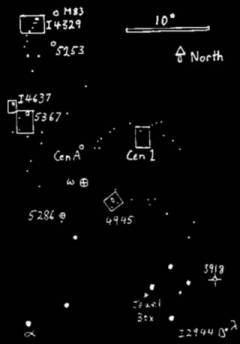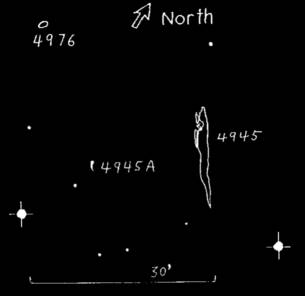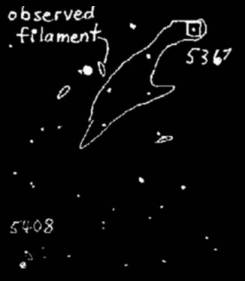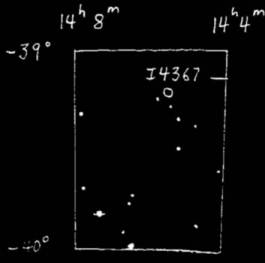BNGC 9. A Very Personal Edition
Back to Index of Beyond the NGC
By Steve Mencinsky, 1993
One of the prime objectives of "Universe" is to provide a forum for the expression of members' views. This is one such; and to emphasise its intensely personal nature this month's BNGC will be the one and only to be written in the first person ("I", "me", "my", "mine").
When people discover that one is an astronomer, there is usually a flood of questions (after the inevitable astronomy / astrology discussion): "What's your favourite object? What's your favourite constellation? (Do you do horoscopes)?" Several of our higher-profile members have very definite answers to such questions. Arthur McNally has Eta Carinae, Mark Suchting - "If I die, I want to be buried facing Orion" (Ilford, October 1990), David Collis-Bird has the Tarantula, Tony Buckley has Hubble's Variable Nebula and NGC 4565, Greg Bryant no doubt has one of those tedious planets; and no, we do not "do" horoscopes.
My personal favourite, for more than a quarter of a century of telescopic observation has been Centaurus, for a variety of reasons that have evolved with time. In all phases of my observing life, it seems to have always been in the thick of the action.
As I child, I stood transfixed staring at Alpha, having learnt that it was one of the "easiest" double stars, willing myself to resolve the components. Shortly afterward, on finding out it was the closest (Proxima I had not yet discovered), I peered at it in eager anticipation, waiting for the flashing messages from its inhabitants that must surely, surely be about to arrive at any moment.
Then came Harley Wood, informing me of Omega. Imagine - a globular cluster (whatever that meant)! And the only one visible to the naked eye! (Harley Wood did not mention 47 Tucanae). And being able to find it - and easily! For an eleven year old, this was heady stuff - leading-edge visual astronomy, from my own backyard.
About this time the 40mm refractor appeared on the scene, with it the thrill of resolving both Alpha and Omega. The significance of the "first and last" in the Greek alphabet struck quite a different resonant chord with the latent philosopher within.
Harley Wood also spoke of the glowing colours of the Jewel Box, again confirmed by the 40mm refractor - all of this without star charts. Was there no end to this magic? Although this object is in Crux, to quote Arthur C. Clarke: "... but greater and later philosophers [than Moon-Watcher] would be prepared to overlook equally striking exceptions to their theories."
Even in my student days, where more than anything else, one learns to be "laid back, indifferent and blasé", Centaurus continued to shine. I can remember word-for-word the conversation on that cold May 1976 first night in the control room of the Molonglo radio telescope, when the chart recorder showed something unprecedented...
Me: Dick - there's something wrong with the chart recorder. Look! Dick: No, that's only Centaurus A coming up to the meridian. Me: Cen A? But we're (consults dials) more than twelve beam position away. Dick: That's Cen A alright. It's the second brightest radio source in the sky. The only thing brighter is the sun. Me: (After a pause) Even brighter than Jupiter? Dick: Oh yes, much brighter. (Nyah! Bryant, Nyah!!!)
So later that night, out came the binoculars and the radio chart, as I traced out in the black Molonglo sky the enormous radio lobes, imagining their appearance at these wavelengths; and listening to the three-second echo of the power relays clicking. It was one of those perfect moments...
More recently, during Halley fever in mid-1986, who can forget the excited, well-meaning if inexperienced comet viewers who "discovered" Comet Centaurus A? One of my then fellow-workers proudly showed me his accurately drawn chart of how his binoculars showed the new "comet" "moving" against the sky! You guessed it - one position was Centaurus A, the other was Omega..
Even today, NGC 5128 deserves a position in the BNGC. Using Andrew Murrell's photographic chart, we were able to observe one of 5128's globular clusters through his 20" telescope from Ilford. It was only a faint star, but - like Omega, so many decades ago - that first sighting of a globular cluster is an unforgettable sight
As I grew older and more affluent, the telescope grew larger and the targets more refined (What's wrong with some self delusion?). There was NGC 5286 - not one of the greatest of globular clusters, but it looks "nice" due to its complete resolution in the 18" telescope; and the bright yellow companion star makes the whole a very cheery sight. There was more recently Tony Buckley's favourite planetary nebula, NGC 3918 - so bright that I could find it by "blinking" with the OIII filter through the 50mm finder - from Newtown!
 It was about this time that my tastes in observation advanced (although I prefer the word "matured") to galaxies. Perhaps it was that evening with Cen A that provided the spark? In any case, there was that excellent evening at Mt White when Andrew pointed out to me the spiral arms of M83. Wow! And all those years I had believed the "professional" literature that held as a dogma that spiral arms were photographically easy to see but never observable visually. True, M83 is fractionally across the border, in Hydra - but again I say: Arthur C Clarke!
It was about this time that my tastes in observation advanced (although I prefer the word "matured") to galaxies. Perhaps it was that evening with Cen A that provided the spark? In any case, there was that excellent evening at Mt White when Andrew pointed out to me the spiral arms of M83. Wow! And all those years I had believed the "professional" literature that held as a dogma that spiral arms were photographically easy to see but never observable visually. True, M83 is fractionally across the border, in Hydra - but again I say: Arthur C Clarke!
 There was NGC 4945 and its companions 4976 and 4945A. From Newtown, I could never make out 4945 with the Suchting 12" mirror, but even from there 4976 was easy. The chart of these three galaxies is from David Collis-Bird's photo, which incidentally is the only photo I have seen that shows all three galaxies. Books and magazines always crop very closely, showing only 4945 itself 4945 is easy to find the two stars drawn as crosses are easily visible to the naked eye - even from Newtown. On the chart, 4945A is the comma-like "tail" extending from the 8th magnitude star, the glare from which makes this galaxy extremely difficult to see. In fact, the visual existence of this galaxy was only confirmed when the "halo" around this star was seen to be clearly elongated in the right direction and by the right amount when compared with halos around other galaxy-less (ungalaxied?) stars of similar magnitude.
There was NGC 4945 and its companions 4976 and 4945A. From Newtown, I could never make out 4945 with the Suchting 12" mirror, but even from there 4976 was easy. The chart of these three galaxies is from David Collis-Bird's photo, which incidentally is the only photo I have seen that shows all three galaxies. Books and magazines always crop very closely, showing only 4945 itself 4945 is easy to find the two stars drawn as crosses are easily visible to the naked eye - even from Newtown. On the chart, 4945A is the comma-like "tail" extending from the 8th magnitude star, the glare from which makes this galaxy extremely difficult to see. In fact, the visual existence of this galaxy was only confirmed when the "halo" around this star was seen to be clearly elongated in the right direction and by the right amount when compared with halos around other galaxy-less (ungalaxied?) stars of similar magnitude.
At one of the Mt Kaputar expeditions, Gordon Garradd showed me NGC 5253, a small but very bright galaxy with a strangely shaped core: like a rectangle with round corners. Gordon informed us that this galaxy was significant in that it had had two supernovae, both of which were much brighter than theory suggested.
Much more recently a further thought occurred (sometimes one can stare at the obvious for years and see nothing). Rather than picking galaxies one at a time (like roses or planets, perhaps?), clearly it would be much more profitable to harvest them by the clusterfull. And - surprise, surprise - once again the telescope turns to Centaurus.
 Probably the most famous of the Centaurus galaxy clusters is the one dominated by IC 4329. Photos of this cluster - often unlabelled - turn up everywhere. For example, it's on the cover of Duffet-Smith's "Practical Astronomy with your Calculator", the context of which remains to me a mystery to this day!
Probably the most famous of the Centaurus galaxy clusters is the one dominated by IC 4329. Photos of this cluster - often unlabelled - turn up everywhere. For example, it's on the cover of Duffet-Smith's "Practical Astronomy with your Calculator", the context of which remains to me a mystery to this day!
I was introduced to this cluster by Wayne Stuart on one of the early Kaputar expeditions. With the 12" telescope and "only " Uranometria II, Wayne and I saw all six galaxies listed in UII and found four others besides. The chart here is compiled from both the Spring 1986 "Deep Sky" and the ESO book mentioned in previous BNGCs. Except for the three galaxies labelled "N" (for Not Visible), all of the drawn galaxies are those that I have actually successfully observed myself, from a total of six observing sites and five telescopes. Except for the three "N's", I have drawn them in approximately the correct size and shape as observed, which in a handful of cases is significantly different to the photo, which shows detail far too faint to be visually observed.
Considering the cluster's perfect declination (-30.3°) and the rather obvious density of galaxies within, it is without doubt one of the most satisfying areas of sky that a galaxy hunter could hope to stalk from our latitudes. When the tracking platform is complete, I hope to be able to add a further handful of galaxies to the list.
As the overall Centaurus chart shows, the cluster is easy to find - it's near M83 and a "coat-hanger" asterism. Having found the coat-hanger (of which the stars labelled X, Y and Z form the north-western part) in the finderscope, project even further NW to find stars P and Q. Moving to the eyepiece of the main telescope and only slightly north, one immediately sees the "kite" shape whose side comers are formed by NGC's 5302 and 5298. From here, one can then roam as one pleases. To assist anyone who wishes to use the detailed chart, I have included on the overall chart the stars X, Y, Z, P, Q as well as IC4329 itself.
The cluster is quite small - virtually all of the observable galaxies lie within a 1.5 degree circle centred on NGC 5304. Following Ted Lumley's example, I have drawn the stars as crosses to distinguish them from the smaller galaxies. The larger the cross - the brighter the star. I have contracted the ESO names, so that for example G40 is actually ESO-445-G40.
 The second important galaxy cluster in Centaurus is Centaurus I (what an appalling lack of imagination!), described in great detail in the Spring 1988 "Deep Sky". This has as its two main galaxies the ellipticals NGC's 4696 and 4709, with about 250 hangers-on. My most pleasant memory of all the Mt Kaputar expeditions by far is an hour spent observing this cluster with Tony Buckley's 14" telescope (at that time, the largest scope on the mountain) using the "Deep Sky" copies of the Schmidt photos as a guide. By the end of the hour, I was satisfied that I had observed EVERY galaxy that was recognisable as such on the chart - and that's a lot of galaxies! My chart here shows only what I was able to see myself in the eastern section of the cluster, again from several sites and with various telescopes, with occasional brief Herschel-type abbreviated comments. I found that the easiest place to begin was to identify 4696 and 4709, then project from the diamond shape of stars to the east of 4709.
The second important galaxy cluster in Centaurus is Centaurus I (what an appalling lack of imagination!), described in great detail in the Spring 1988 "Deep Sky". This has as its two main galaxies the ellipticals NGC's 4696 and 4709, with about 250 hangers-on. My most pleasant memory of all the Mt Kaputar expeditions by far is an hour spent observing this cluster with Tony Buckley's 14" telescope (at that time, the largest scope on the mountain) using the "Deep Sky" copies of the Schmidt photos as a guide. By the end of the hour, I was satisfied that I had observed EVERY galaxy that was recognisable as such on the chart - and that's a lot of galaxies! My chart here shows only what I was able to see myself in the eastern section of the cluster, again from several sites and with various telescopes, with occasional brief Herschel-type abbreviated comments. I found that the easiest place to begin was to identify 4696 and 4709, then project from the diamond shape of stars to the east of 4709.
This cluster is almost as satisfying to observe as IC4329 et al. It's a much larger cluster - the main portion is 1.5 x 3 degrees, and it's somewhat further south: -40.5 to -42 degrees; and obviously comprised of many more galaxies (than IC4329). No doubt the photographic extent and depth is considerably larger again.
The western portion of this cluster I have observed with only U II and have seen every object listed therein. If our astrophotographers could supply a photo of this area, perhaps - suitably annotated - it could grace a future BNGC.
 The ESO book shows other wonders in Centaurus. Following last month's theme of cometary globules, naturally Centaurus boasts one as well. NGC 5367 itself is only a very small nebula, but the ESO book shows an extension over a degree long, as shown in the diagram. Although Andrew and I observed 5367 very carefully from Ilford, we could only see in the 18" one very small and faint filament (as shown on the chart) - but it was worth the effort. The small galaxy NGC 5408 (beware: first edition U II marks it as a planetary nebula and has the wrong NGC number - 4508) is also easily seen.
The ESO book shows other wonders in Centaurus. Following last month's theme of cometary globules, naturally Centaurus boasts one as well. NGC 5367 itself is only a very small nebula, but the ESO book shows an extension over a degree long, as shown in the diagram. Although Andrew and I observed 5367 very carefully from Ilford, we could only see in the 18" one very small and faint filament (as shown on the chart) - but it was worth the effort. The small galaxy NGC 5408 (beware: first edition U II marks it as a planetary nebula and has the wrong NGC number - 4508) is also easily seen.
Also in the ESO book is a comprehensive article - and excellent photos - of the Lambda Centaurus nebula (IC2944) and the associated Thackeray globules: dark blobs against a bright background. (Perhaps Julia Palmer (Bryant) could enlighten us as to what they really are?). With my most recent observing partner, Lorraine Gall (Mencinsky), we successfully observed three of these difficult dark patches on the Ilford New Moon weekend before Easter. As part of the exercise, we were also able to trace out much of the IC nebula itself - no mean feat. Since this is such a rich and complex area, no chart has been attempted.
 We used the photos in the ESO book as our chart. Even today, Centaurus still holds surprises. On the recent Anzac day weekend at Ilford, I was called upon by Clive Milne and Warren Taylor to inspect a bright (by BNGC standards) fuzzy that they had found on their way to NGC 5367. There was terrific excitement - was this the legendary Great Ilford Comet? Alas, when the object had not moved after three nights we decided it was not. Clive phoned me a few days later with the Arizona database having informed him that we had observed ESO-325-G51, aka IC4367 , an Sc galaxy. The detailed chart shows the location of said galaxy in relation to the one small segment of U II chart 404.
We used the photos in the ESO book as our chart. Even today, Centaurus still holds surprises. On the recent Anzac day weekend at Ilford, I was called upon by Clive Milne and Warren Taylor to inspect a bright (by BNGC standards) fuzzy that they had found on their way to NGC 5367. There was terrific excitement - was this the legendary Great Ilford Comet? Alas, when the object had not moved after three nights we decided it was not. Clive phoned me a few days later with the Arizona database having informed him that we had observed ESO-325-G51, aka IC4367 , an Sc galaxy. The detailed chart shows the location of said galaxy in relation to the one small segment of U II chart 404.
And so we come to the end of Centaurus - but only for now. I am certain that it will remain in the thick of the action. For example, I confidently predict that both comet Bryant-Palmer at perihelion and the first definite proof of non-terrestrial intelligent life will be found in Centaurus. Fortunately, we will never observe any bright planets there. And that, too, is how it should be.

